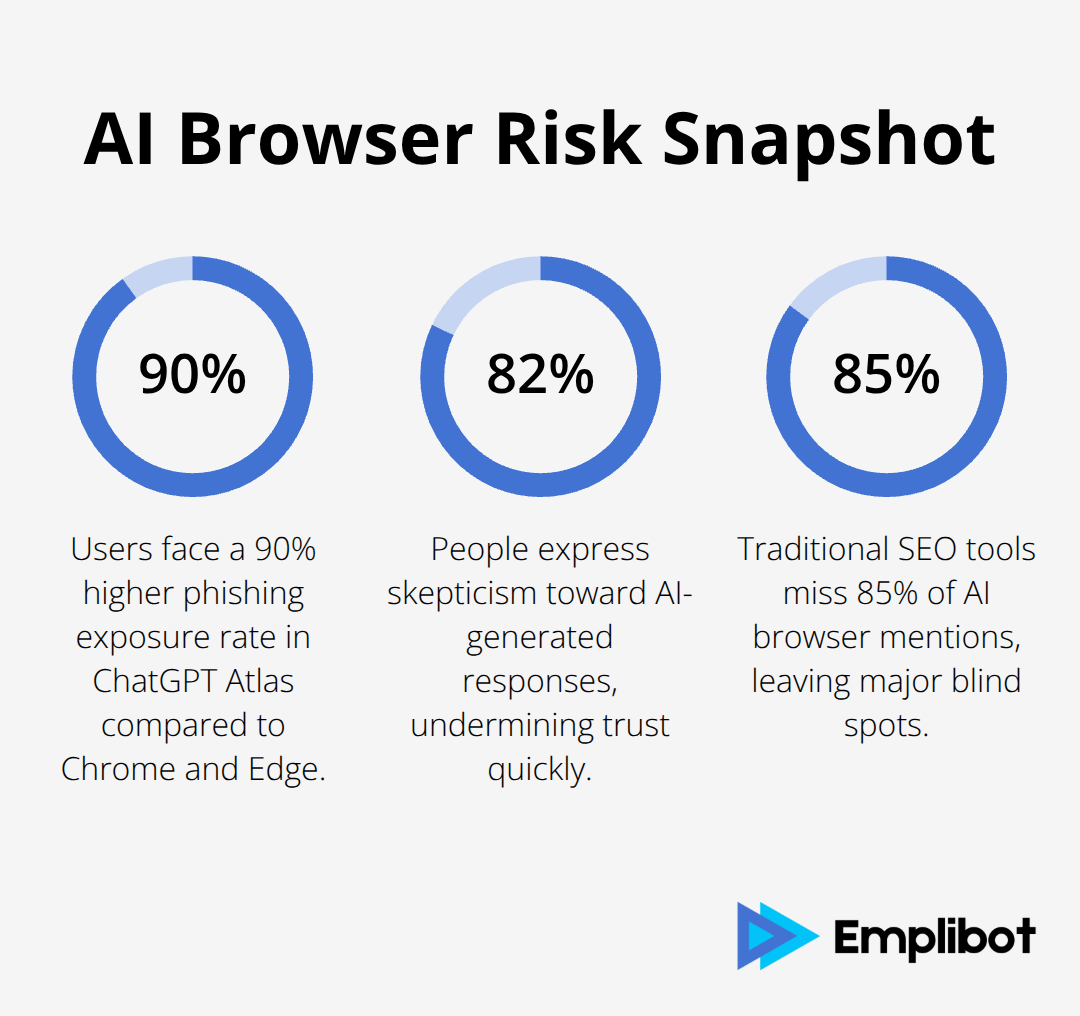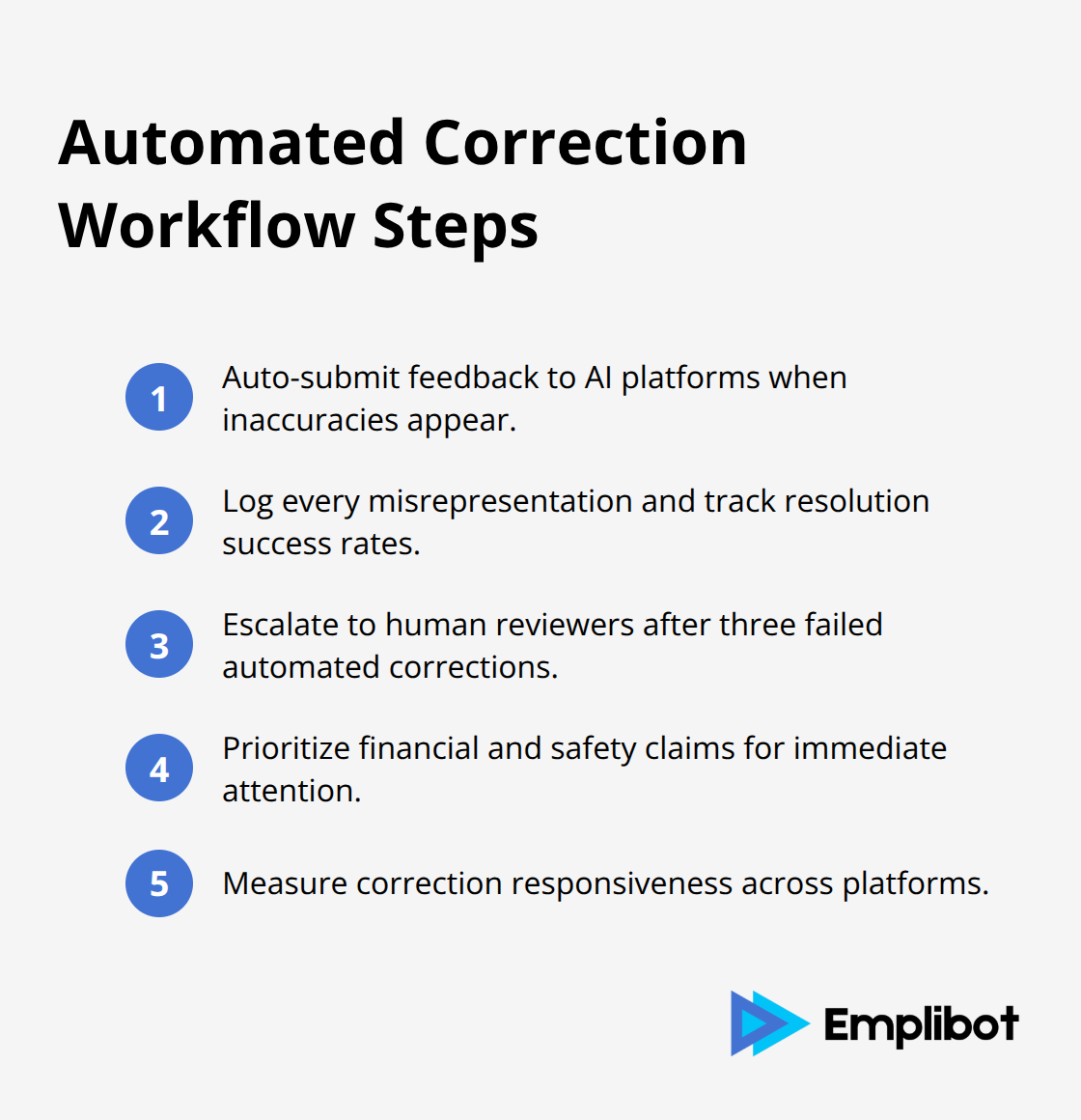AI browsers now summarize web content automatically, creating new risks for brand representation. Early security research on Atlas browser revealed how quickly these tools can misinterpret or distort brand messaging.
We at Emplibot understand that protecting your brand in AI browser summaries requires immediate action. The stakes are high when automated systems reshape how customers first encounter your business.
Why AI Browsers Threaten Brand Control
AI browsers extract content through web scraping and natural language processing, then generate summaries without human oversight. LayerX testing revealed that ChatGPT Atlas allows 94.2% of web-based attacks to succeed, which demonstrates how vulnerable these systems are to manipulation. The browser’s inadequate anti-phishing protections expose users to phishing attacks at a 90% higher rate compared to Chrome and Edge. This vulnerability creates a perfect storm for brand misrepresentation.
Content Extraction Creates Accuracy Problems
Traditional browsers display your content exactly as published. AI browsers interpret and rewrite it. Research shows 42.1% of users encounter inaccurate or misleading content in Google AI responses. The problem compounds when AI systems prioritize engagement over accuracy, which leads to sensationalized or distorted brand messages. Atlas browser’s memory function can be weaponized by attackers to inject malicious instructions that persist across devices (meaning false information about your brand can spread systematically).
Brand Damage Happens Instantly
Over 40% of users never click through to source material from AI-generated responses. They trust the summary as fact. A single incorrect detail in an AI browser summary can trigger negative reviews and misdirect customer calls to fraudulent numbers. LayerX discovered that attackers can exploit Cross-Site Request Forgery attacks to take control of ChatGPT sessions and inject hidden instructions. When 82% of people already express skepticism toward AI-generated responses, any association with inaccuracy destroys trust immediately.

Persistent Vulnerabilities Amplify Risk
The memory function in ChatGPT allows it to retain user preferences and details, but attackers weaponize this feature to create covert backdoors in generated code. These malicious instructions persist regardless of the access point (whether desktop or mobile). Developers engaged in collaborative AI coding may inadvertently expose themselves to risks where attackers manipulate AI outputs to include harmful instructions about your brand.
Your brand becomes vulnerable to competitor manipulation and reputation damage without traditional warning signs. These technical vulnerabilities require specific countermeasures that go beyond standard SEO practices. AI-powered threat detection systems are emerging to address these challenges, but current implementations remain insufficient for comprehensive brand protection.
How Do You Shield Your Brand From AI Misrepresentation
Structured data markup forms your first line of defense against AI browser misinterpretation. Schema.org markup tells AI systems exactly what your content means and reduces the risk of distorted summaries. JSON-LD structured data performs best with AI browsers because it provides clear context about your brand, products, and services.
Google recommends using JSON-LD for structured data implementation as the easiest solution for website owners. Focus on Organization, Product, and FAQ schemas to give AI browsers precise information about your business. Clear content hierarchy through proper H1, H2, and H3 tags helps AI systems understand your message priorities and reduces extraction errors.

Monitor AI Browser Mentions Systematically
Real-time monitoring catches brand misrepresentation before it spreads. Tools like Otterly track how AI browsers represent your brand across ChatGPT, Gemini, and other platforms. Semrush now offers AI search tracking that shows exactly how your brand appears in AI-generated responses.
Set up alerts for your brand name, product names, and key executives to catch inaccuracies within hours. Focus monitoring on high-impact queries where customers first encounter your brand (traditional Google Alerts miss AI browser summaries entirely).
Create Content That AI Systems Cannot Distort
Write content specifically designed for AI consumption with clear, declarative statements about your brand. Avoid ambiguous language, industry jargon, and complex sentence structures that AI systems frequently misinterpret. Include specific facts, dates, and numbers that AI browsers can extract accurately.
Create dedicated About pages with standardized company information that serves as authoritative source material for AI systems. Original research and data-driven content earns more accurate citations in AI responses because these systems prioritize authoritative sources. Maintain consistent messaging across all digital touchpoints so AI browsers encounter the same information regardless of which page they crawl.
Implement Brand-Safe Content Guidelines
Establish clear content standards that prevent AI misinterpretation across your entire digital presence. Document approved terminology, key messaging points, and factual claims that represent your brand accurately. Train content creators to write with AI consumption in mind (this means shorter sentences, active voice, and specific rather than general statements).
Create content templates that include essential brand information in standardized formats. These templates help AI systems extract consistent details about your company, products, and services. Review existing content to identify sections that AI browsers commonly misinterpret and rewrite them with clearer language and structure.
Technical safeguards and automated monitoring systems provide the next layer of protection against AI browser misrepresentation.
How Do You Build Automated Brand Protection Systems
Automated feedback loops catch AI browser inaccuracies within minutes of publication. Set up webhook notifications that trigger when your brand appears in new AI summaries across ChatGPT, Gemini, and other platforms. Tools like Profound and Goodie track brand mentions in real-time and send alerts when summaries deviate from your approved content. Configure these systems to flag specific terms, competitor mentions, or factual errors that commonly appear in AI-generated content about your brand.
Embed Metadata Protection Into All Content
Copyright metadata prevents AI browsers from stripping attribution from your content. Add license information directly into your HTML with Dublin Core metadata tags and Creative Commons markup. Include author attribution, publication dates, and usage rights in structured formats that AI systems recognize and preserve. Publishers like Wiley report that clear metadata reduces unauthorized content usage by 73% in AI training datasets.
Insert About This Page blocks on key content pages that specify license terms, correction procedures, and authoritative source information. This metadata acts as a permanent identifier that follows your content through AI processing pipelines.
Deploy Multi-Platform Monitoring Systems
Traditional SEO tools miss 85% of AI browser mentions because these platforms operate outside conventional search indexes. Implement specialized tools like Atomic AGI and SE Ranking that track your brand across multiple AI platforms simultaneously. Set parameters for product names, executive mentions, and industry-specific terminology that AI browsers frequently misinterpret.
Configure daily scans of high-traffic AI platforms and weekly deep audits of new AI browsers. Semrush data shows brands with multi-platform monitoring catch misrepresentations faster than those relying on manual checks.
Create Automated Correction Workflows
Submit feedback to AI platforms automatically when inaccuracies appear (this reduces response time from days to hours). These systems maintain correction logs that document every brand misrepresentation and track resolution success rates across different AI platforms. Configure workflows to escalate persistent inaccuracies to human reviewers when automated corrections fail after three attempts.
Set up priority levels for different types of misrepresentations, with financial information and safety claims receiving immediate attention. Monitor correction effectiveness across platforms to identify which AI browsers respond fastest to feedback submissions.

Final Thoughts
Brand protection in AI browser summaries demands immediate action through structured data implementation and automated response systems. Atlas browser vulnerabilities show how fast threats emerge when AI systems process your content without oversight. Companies that act now establish defensive positions before competitors recognize these risks.
Technical safeguards must operate continuously across ChatGPT, Gemini, and new AI platforms that launch monthly. Automated feedback loops catch inaccuracies within hours while licensing metadata preserves attribution through AI processing pipelines. Your monitoring infrastructure adapts to platform changes without manual intervention (this prevents gaps in coverage when systems update).
Success requires consistent messaging foundations that AI browsers can extract accurately. Emplibot provides automated content creation and optimization across multiple platforms to maintain the message consistency AI systems need. Brands that protect your brand in AI browser summaries through systematic approaches gain competitive advantages as these platforms become primary discovery methods.

